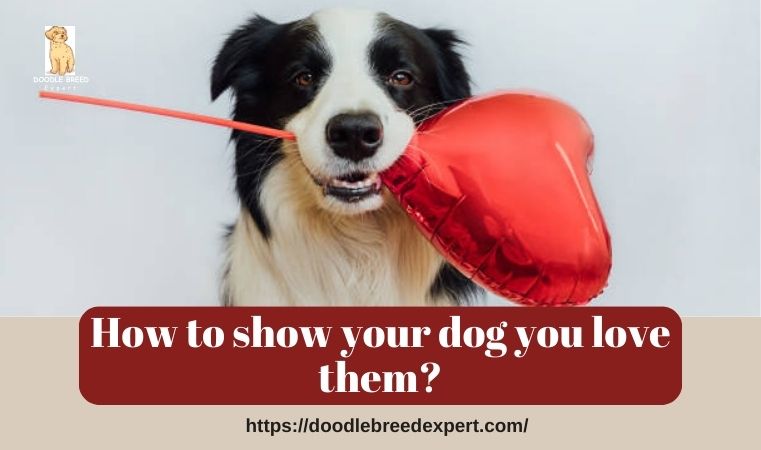How to show your dog you love them? While it may be possible to discern whether a dog adores you, do you possess the ability to reciprocate that affection? There are significant distinctions between how humans and canines express affection. While you may find it awkward when someone pats your stomach, a dog can adore a nice belly rub. The promise of a love letter written by hand has an effect on the human heart to race, but for a dog, this does not mean anything, particularly in the form of a Shakespearean sonnet.
Valentine’s Day, a day of love and affection, is the perfect time to go above and beyond and express your love to your furry friend with a Valentine’s Day gift. Spend quality time together doing something they like, give a special treat, or go for a leisurely walk in the park. Even if your dog doesn’t understand the importance of a Valentine’s Day, it will appreciate if some extra time and attention are given to it as a part of a Valentine’s Day gift. Ultimately, the bond and connection you share genuinely matters, regardless of the occasion.
If you love your dog, you should try showing your love to them in a way they would understand. Here are the ways to love your dog as much as they love you.
Communicate and Interact with Your Dog
Interaction and communication with the dog can be so rewarding, although they cannot understand the language like humans. Dogs can understand quite a lot; on average, they would catch about 165 words. These tend to be standard terms like “walk” or “dinner,” which they learn through repetition and association.
The dog’s vocabulary can be expanded amazingly since even “I love you” can be entered into his active dictionary. This time, it might not even be perceived as actual words, but rather, the tone of the voice and the actions accompanying the positive verbal remarks are understood. How praise is done is crucial when doing it in any form. Direct praise, as in “Good girl! ” has a much more marked effect on the dog’s behaviour than a general, more abstract “Excellent canine.”
Moreover, one’s tone of voice is the key. Dogs adore it when there is a singing tone. This tone is very akin to human baby-tickling infant-speak. They can find the exaggerated cadence more engaging and more understandable. Ultimately, the dog may not understand our language the way we do. Still, they are very closely attuned to our tone, gestures, and actions, which form a unique, meaningful manner of communication with their human companions.
Sustain affectionate eye Contact.
So, eye contact in an affectionate way really does bind that bond together between you and the furry one. While dogs use sustained eye contact primarily for dominance, human-canine eye contact can mean affection and communication.
Dogs will often employ their eyes to secure reassurance from their owner or express emotions such as joy or hunger. While you and your dog look at each other, oxytocin, often called the ‘love hormone,’ is released in your bodies. This hormone is essential to form social bonds and, therefore, to raise feelings of attachment and trust between you and your pet.
Studies show a dog’s oxytocin level would jump far more with long gazes—those that last for more than a minute—than with fleeting looks. Such a leap in oxytocin not only strengthens the emotional bond between you and your furry friend but is also associated with feelings of well-being and satisfaction for both of you.
So, the next time you exchange glances with your furry friend, remember that it is not a simple exchange but the sealing of that bond that makes your relationship just what it is.

Pet Them Regularly
Dogs often show affection by leaning against you. However, most dogs are ultimately not large or sturdy enough for you to lie on them.
According to Russell Hartstein, a dog behaviorist at FunPawCare, when dogs lean on you, they usually don’t want you to lean back on them. Instead, they enjoy tactile stimulation and the affection of being petted by a family member.
It feels comforting, and most importantly, petting your dog cannot hurt. The heads and stomachs of a great majority of dogs adore petting. Almost every dog will be content with a soft massage behind the ears.
Give Cuddles and Sleepytime Priority
While dogs may have derived from pack animals, it is unsurprising that they are more prone to sleeping in groups. Letting your dog sleep on your bed or couch clearly indicates love and acceptance of the dog as a valued member of your family.
Research on free-ranging canines—those living without human intervention—suggests that dogs sleep more soundly in the company of others than alone. When solitary, a dog may remain somewhat vigilant, keeping one eye open for things that might threaten, such as intruders or—comically—the scary vacuum cleaner. But when the dog is in the security of a group, vigilance decreases.
When in a cuddle pile or a group setting, dogs feel more secure than when they are alone, as they see safety in numbers. It also becomes challenging for potential threats to surprise them when surrounded by their friends. This extra warmth and being comfortable huddled with others add to the homely atmosphere of a common resting site, reinforcing social bonds among members.
Read Also: Do Aussiedoodles Shed?
Play on Their Terms
In the play, the canines may wrestle or chase each other to set a hierarchy and release tension amicably. The primary motivations towards play among humans and dogs are not usually competition but communication or bonding. Playing with them demonstrates affection and strengthens the bond between humans and dogs.
Games entertain dogs, but they are an excellent way to teach them boundaries and expectations. For instance, if you stop playing tag after your dog becomes too rough, most likely, next time, he will be much more tender to keep playing the game. This kind of feedback is beneficial when training a dog.
Most dogs care about your undivided attention while playing, regardless of the outcome. It doesn’t hurt to let them win now and then, though.
Stay Active
We all love physical activity; so do our dogs. As such, everybody knows how dogs love outings; hence, two enjoy visiting places in tandem for their territory marking or fun with a stick gathering. Choose an activity such as swimming, hiking, or any other activity that will be more engaging, where possible, and will make them work out more.
You may realize that you and your companion move synchronously if you learn to see this connection. This may involve, for example, imitating the movements and stops of the owner, as well as directing the owner’s gaze. A 2017 study showed that even off-lead dogs tended to imitate the owner’s activities and most often wanted to keep close.
Signs of affection that your dog might oppose.
Affection signs are not as easy to tell in another species. For example, your dog could be turned off by how you show them affection, and the preference might be the opposite of what it would be if you were not careful. In general, dogs do not like:
- Pecks on the jowl: Canines may consider such a peck a toothless provocation to bite. Nips are just a little bit more than tickle bites and are used between pack members to taunt or show dominion. Your dog’s greeting response could be a bit more of a dental form of play, biting, for instance.
- Hugging: They dislike arms around them as one embraces them, especially in earlier times, as you are still trying to get to know each other.
- Paw Massage: For humans, pedicures and foot massages are just the enjoyment of life, but in dogs, this is an overload of blood vessels and nerve terminals. Allowing someone to touch their paws, even gently, causes dogs enormous stress.
Conclusion: How to show your dog you love them
How to show your dog you love them? Love is delivered to your dog by words and deeds. Deeds include spending quality time together, walks, games, and so on. Use kind wording and motivational methods. Reward the very well-behaved with treats. Giving physical affection like belly rubs and a good hug also helps bind the two of you.
Regular grooming sessions can also be a source of showing care and attention. Pay attention to the needs and preferences of the dog, which could be a particular toy or a nice place to nap. Establish routines and be reliable, as dogs thrive on predictability and stability. How to show your dog you love them isn’t just about grand gestures; it’s about everyday interactions filled with love and respect. You can create a strong and lasting connection with your furry friend by being attentive and responsive to their needs.






